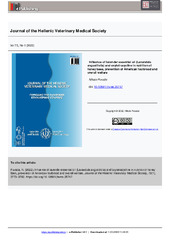Приказ основних података о документу
The influence of single lavender essential oil in honey bee prevention of American foulbrood and overall welfare
| dc.creator | Puvača, Nikola | |
| dc.creator | Halfawi, Rabea Ai Bashir M. | |
| dc.creator | Ćosić, Milivoje | |
| dc.creator | Prodanović, Radivoj | |
| dc.creator | Soleša, Dragan | |
| dc.creator | Vladisavljević, Radovan | |
| dc.creator | Lekić, Snežana | |
| dc.creator | Aćimović, Milica | |
| dc.date.accessioned | 2022-05-23T07:00:56Z | |
| dc.date.available | 2022-05-23T07:00:56Z | |
| dc.date.issued | 2022 | |
| dc.identifier.issn | 1792-2720 | |
| dc.identifier.uri | http://fiver.ifvcns.rs/handle/123456789/2681 | |
| dc.description.abstract | Recently, there has been an increasing demand for natural, healthy, and safe products without residual antibiotics for human consumption, particularly bee products. Beekeepers have been struggling with this problem many years, having in mind often occurrence of American foulbrood (AFB), which is one of the most severe honey bee brood diseases, and in the past have been successfully eradicated with heavy usage of antibiotics. Such controlled, or mostly uncontrolled usage of antibiotics in fighting against American foulbrood lead to a residual quantity of antibiotic in honey. To overcome this problem, this research aimed to investigate the influence of single essential oil (Lavandula angustifolia) in protecting bees against AFB compared to the antibiotic oxytetracycline. Totally three treatments were formed artificially infected with P. larvae spore suspension, at concentration 2×109 spore/ml. The course of the disease was regularly monitored. Treatment one (T1) did not receive antibiotic therapy. Treatment two (T2) was given lavender essential oil at a concentration of 0.1% of sugar syrup. The treatment was applied for 30 days, at 48h intervals. Treatment three (T3) received antibiotics in the sugar syrup at a concentration of 0.1%, respectively. Clinical and laboratory examinations were performed on days 10, 20, 40 and 60, respectively. Besides, L. angustifolia essential oil rich in Ethanol, 2- (2-ethoxyethoxy) - (13.05%), linalool (10.71%), α-Terpinyl acetate (10.93%) and linalool acetate (9.60%), showed its positive effects against antibiotics in combat of American foulbrood, further research with a specifically designed qualitative and quantitative mixture of essential oils are more than necessary because single essential oil is not enough and didn’t show expected results. | sr |
| dc.language.iso | en | sr |
| dc.publisher | Athens : Hellenic Veterinary Medical Society | sr |
| dc.rights | openAccess | sr |
| dc.rights.uri | https://creativecommons.org/licenses/by-nc-nd/4.0/ | |
| dc.source | Journal of the Hellenic Veterinary Medical Society | sr |
| dc.subject | essential oils | sr |
| dc.subject | bees | sr |
| dc.subject | honey | sr |
| dc.subject | nutrition | sr |
| dc.subject | medicinal plants | sr |
| dc.subject | lavender | sr |
| dc.subject | welfare | sr |
| dc.title | The influence of single lavender essential oil in honey bee prevention of American foulbrood and overall welfare | sr |
| dc.type | article | sr |
| dc.rights.license | BY-NC | sr |
| dc.citation.epage | 3782 | |
| dc.citation.issue | 1 | |
| dc.citation.rank | M23 | |
| dc.citation.spage | 3773 | |
| dc.citation.volume | 73 | |
| dc.identifier.doi | 10.12681/jhvms.25747 | |
| dc.identifier.fulltext | http://fiver.ifvcns.rs/bitstream/id/7413/puvaca.pdf | |
| dc.identifier.scopus | 2-s2.0-85129616634 | |
| dc.identifier.wos | 00079401740002 | |
| dc.type.version | publishedVersion | sr |


